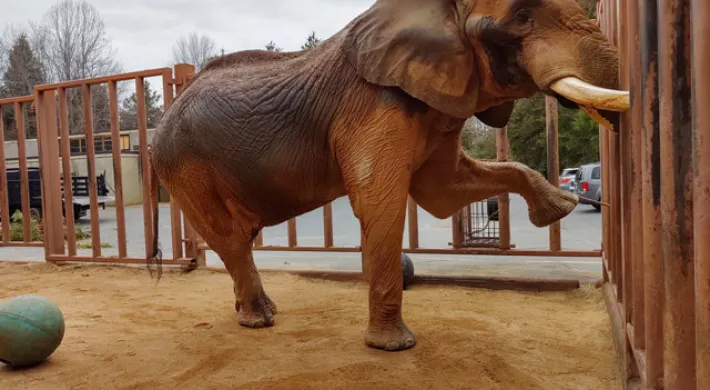ASHEBORO, N.C. — The North Carolina Zoo and its original elephant, C’sar, have officially marked 50 WILD Years together. C’sar’s journey from the wild plains of Kenya to his home in Asheboro is a story of survival, adaptation, and the enduring spirit of one of nature's most magnificent creatures.
Despite the challenges that have marked his life — arthritis, near blindness, and a neurological condition affecting his left ear — C’sar continues to thrive under the dedicated care of his keepers. He was one of the first elephants in the world to receive cataract surgery, and later became the first elephant in history to receive corrective contact lenses to improve his vision. Through meticulous training, Zoo team members provide the physical, mental, and emotional care C’sar needs to stay engaged and active.
From creative yoga poses designed to enhance his balance and range of motion to specialized treatments for his eyes and feet, every aspect of C’sar’s care is tailored to his unique needs. C’sar’s daily routine includes adequate rest, exercise, and engaging in social feeding with his herd thanks to innovative feeders designed by local welding students from Randolph Community College. He recognizes his name, enjoys the occasional swim, and continues to roam the habitat he has called home for the last 46 years.
“C’sar is deeply loved and respected by staff and guests from around the world,” says Zoo Public Relations Officer Sara Pack. “He is the longest-tenured resident of our Zoo and the oldest African bull elephant in all of North America, so he is something of a celebrity. He has experienced many changes at the Zoo, and generations continue to visit him year after year.”
C’sar was first brought under human care in 1976 when he was approximately two years old. He later came to the North Carolina Zoo from the Toledo Zoo in Ohio on July 25, 1978, when he was just four years old. Now, weighing around 12,000 pounds and standing roughly 11 feet tall at the shoulder, C’sar remains a symbol of the Zoo’s mission to save wildlife and wild places.
During his 50th birthday party, C’sar used his muscular trunk, excellent hearing, and intimate knowledge of his sprawling habitat to locate and devour a custom-made ice pop birthday “cake” and other treats, like watermelon, sweet potatoes, and carrots, which are not part of his typical daily diet. Zoo team members led guests in a chorus of “Happy Birthday” followed by cheers as C’sar demolished his animal-friendly birthday piñata. Attendees were also able to sign an elephant-sized card and pose for photos near the herd.
C’sar’s story is not merely one of individual triumph, but also a symbol of the broader conservation efforts championed by the North Carolina Zoo. Since 1998, the Zoo has been at the forefront of elephant conservation in West Africa, utilizing satellite tracking collars to mitigate human-elephant conflict, delineate protected areas, and enhance understanding of elephant ecology. In Nigeria, the Zoo’s work to refine strategies against ivory poaching has been instrumental in protecting the country’s remaining elephant population.
To learn more about the world’s largest natural habitat zoo and its lifesaving conservation efforts, visit www.nczoo.org.



